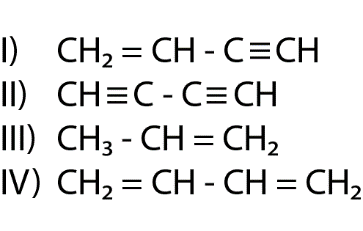
The length of carbon-carbon single bond of the compounds

is expected to increase in the order
(A) Ⅲ > Ⅱ > Ⅰ > Ⅳ
(B)Ⅰ > Ⅲ > Ⅱ > Ⅳ
(C) Ⅲ > Ⅳ > Ⅰ > Ⅱ
(D)Ⅱ > Ⅳ > Ⅰ > Ⅲ

Answer
473.1k+ views
Hint: The length of the carbon-carbon single bond depends upon the hybridization of the carbon atom. The hybridization of the carbon contains S and P characters. More will be the p percentage, more will be the length of the carbon-carbon single bond.
Complete step by step solution:
For comparing the length of the carbon-carbon single bond, we need to check the hybridization of the carbons bonded via single bonds in each option.
In
In
In
Checking each option separately,
(Ⅰ)

(Ⅱ)

Both
(Ⅲ)

(Ⅳ)

Here, both
Now, we know as the p character increases, the bond length of the carbon-carbon single bond increases.
Combining the percentage p character of the carbon-carbon single bond,
For the molecule in option (Ⅰ),
Total p percentage of carbons bonded via single bond =
(
For the molecule in option (Ⅱ),
Total p percentage of carbons bonded via single bond =
(
For the molecule in option (Ⅲ),
Total p percentage of carbons bonded via single bond =
(
For the molecule present in option (Ⅳ),
Total p percentage of carbons bonded via single bond =
(
Now, we can easily compare on the basis of combined percentage p character.
The molecule in option (Ⅲ) will have the longest carbon-carbon single bond length followed by (Ⅳ),
(Ⅰ) and (Ⅱ).
Therefore, the correct order will be Ⅲ > Ⅳ > Ⅰ > Ⅱ
So, the correct option will be option C: Ⅲ > Ⅳ > Ⅰ > Ⅱ.
Additional information:
A carbon-carbon bond is a covalent bond between two carbon atoms. Single bond is the most common form: a bond composed of two electrons, one from each of the two atoms. The carbon-carbon single bond is a sigma bond and is formed between one hybridized orbital from each of the carbon atoms.
Note:
The carbon-carbon single bond length is directly proportional to the combined percentage of p of both the carbon atoms bonded via single bond and inversely proportional to the combined percentage of s of both the carbon atoms bonded via single bond.
As the combined percentage of p increases, bond length of carbon-carbon single bond increases.
Complete step by step solution:
For comparing the length of the carbon-carbon single bond, we need to check the hybridization of the carbons bonded via single bonds in each option.
In
In
In
Checking each option separately,
(Ⅰ)

(Ⅱ)

Both
(Ⅲ)

(Ⅳ)

Here, both
Now, we know as the p character increases, the bond length of the carbon-carbon single bond increases.
Combining the percentage p character of the carbon-carbon single bond,
For the molecule in option (Ⅰ),
Total p percentage of carbons bonded via single bond =
(
For the molecule in option (Ⅱ),
Total p percentage of carbons bonded via single bond =
(
For the molecule in option (Ⅲ),
Total p percentage of carbons bonded via single bond =
(
For the molecule present in option (Ⅳ),
Total p percentage of carbons bonded via single bond =
(
Now, we can easily compare on the basis of combined percentage p character.
The molecule in option (Ⅲ) will have the longest carbon-carbon single bond length followed by (Ⅳ),
(Ⅰ) and (Ⅱ).
Therefore, the correct order will be Ⅲ > Ⅳ > Ⅰ > Ⅱ
So, the correct option will be option C: Ⅲ > Ⅳ > Ⅰ > Ⅱ.
Additional information:
A carbon-carbon bond is a covalent bond between two carbon atoms. Single bond is the most common form: a bond composed of two electrons, one from each of the two atoms. The carbon-carbon single bond is a sigma bond and is formed between one hybridized orbital from each of the carbon atoms.
Note:
The carbon-carbon single bond length is directly proportional to the combined percentage of p of both the carbon atoms bonded via single bond and inversely proportional to the combined percentage of s of both the carbon atoms bonded via single bond.
As the combined percentage of p increases, bond length of carbon-carbon single bond increases.
Latest Vedantu courses for you
Grade 11 Science PCM | CBSE | SCHOOL | English
CBSE (2025-26)
School Full course for CBSE students
₹41,848 per year
Recently Updated Pages
Master Class 11 Accountancy: Engaging Questions & Answers for Success

Master Class 11 Physics: Engaging Questions & Answers for Success

Master Class 11 Business Studies: Engaging Questions & Answers for Success

Master Class 11 Maths: Engaging Questions & Answers for Success

Master Class 11 Chemistry: Engaging Questions & Answers for Success

Master Class 12 Biology: Engaging Questions & Answers for Success

Trending doubts
How much is 23 kg in pounds class 11 chemistry CBSE

What was the first capital of Magadha APatliputra BVaishali class 11 social science CBSE

How does Amoeba obtain its food a Endocytosis b Exocytosis class 11 biology ICSE

What is the molecular weight of NaOH class 11 chemistry CBSE

What is food class 11 biology CBSE

Write the differences between monocot plants and dicot class 11 biology CBSE




